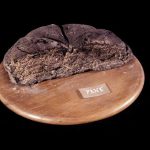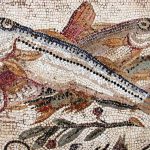Chapters
Undoubtedly, the most important Roman writer who dealt with culinary literature was a certain Marcus Gavius, commonly known as Apicius. He is the author of the cookbook De re coquinaria libri X.
The book contains a number of Greek-language terms, and its recipes cover both demanding and less demanding gourmets, which may indicate a compilation of the work. Thanks to this priceless work, we get to know the richness of ancient dishes and diets, the influence of which can be traced back to the late Middle Ages.
In the following, selected recipes of Roman cuisine.
Root wine
The composition of this excellent spiced wine is as follows. Into a copper bowl put 6 sextarii1 of honey and 2 sextarii of wine; heat on a slow fire, constantly stirring the mixture with a whip. At the boiling point add a dash of cold wine, retire from stove and skim. Repeat this twice or three times, let it rest till the next day, and skim again. Then add 4 ounces of crushed pepper,2 3 scruples of mastich, a drachm each of nard or laurel leaves and saffron, 5 drachms of roasted date stones crushed and previously soaked in wine to soften them. When this is properly done add 18 sextarii of light wine. To clarify it perfectly, add crushed charcoal3 twice or as often as necessary which will draw the residue together and carefully strain or filter through the charcoal.
– Apicius, De re coquinaria, I.1
Honey wine (Mulsum)
Mulsum was a sweet wine that the ancient Romans enjoyed very much. In ancient times, wines usually had a bitter taste because wild grapes were not sweet. Nowadays, after many “crosses”, such sweet grapes have been obtained. The Romans, in order to eliminate the bitter aftertaste of wine, added honey to it. And so the mulsum drink was born.
To create Roman honey wine you need:
- half a cup of warm pure honey
- a bottle of semi-dry white wine
Warm honey is added to a bottle of wine, which is then stored in the refrigerator for 24 hours. After this time, the wine will acquire its best taste.
Lucanian sausages
These sausages became popular in Roman cuisine thanks to soldiers who served in the south of Italy, in Lucania, around the 2nd century BCE. To this day, spicy, spicy and smoked Lucan sausages are made in many parts of the world (from Palestine to Brazil).
To make Lucan sausages (serves six), you will need:
- 45 grams of minced bacon
- 2 tablespoons of pine nuts
- 20 grains of black pepper
- 1 small spoonful of chopped fresh or dried anise
- 2 small spoons of dried savoury
- 1 heaped teaspoon of ground cumin
- 1 teaspoon ground black pepper
- 2 teaspoons chopped parsley
- 3 tablespoons of fish sauce
- 6 of 30cm intestines, e.g. pork intestines for sausages or natural casings (ready-made intestines for sausages)
Mix all ingredients well (a food processor is recommended). Marinate fresh pork intestines in salt and clean them. Tie one end of the intestine. Fill the centre of the intestine with a mixture of ingredients. Obtained sausages can be additionally smoked over a fire or grill to get a smoke flavour.
Crepes with milk (Ova spongia ex lactate)
- 8 eggs
- 600ml milk
- 100ml of olive oil (not the olive oil)
- some honey and pepper
Mix the eggs, milk and olive oil to make a pancake batter. Then we bake. You can serve it with honey and pepper on top.
Boiled eggs in pine nut sauce
Eggs were one of the most popular appetizers of the ancient Romans. One of the suggestions is boiled eggs in pine nut sauce.
Will be needed:
- 4 medium-boiled eggs
- 2 ounces of pine nuts
- 3 tablespoons of vinegar
- 1 small spoonful of honey
- a pinch of pepper and lovage (or celery leaves)
Soak pine nuts in vinegar for 3-4 hours. Then mix all the spices in the prepared sauce (according to an ancient recipe, the resulting sauce was mixed with garum). Pour the sauce over the boiled eggs.
Garum
What ketchup or mustard is to us today was garum to the Romans. Garum was an essential addition to exquisite Roman cuisine. It appears in most of the recipes preserved in Apicius ‘ On Culinary Arts.
It was prepared like this: small fish or fish innards (e.g. mackerel, anchovies, sardines, sprats, mullet, anchovies, tuna blood) were dropped into the dish. All this was salted and mixed in a large dish with herbs (such as dill, fennel, coriander, celery, savoury, sage, rue, mint, lovage, thyme, and marjoram). Successive layers of fish, salt and herbs were laid on top of each other. Then the filled vessel was exposed to the sun for up to seven days (sometimes even a month). During this time, the fermentation process took place in the vessel, during which juice was released from the fish. The contents of the vessel were drained and the liquamen liquid obtained was used as a spice.
However, it is not recommended to try your own product, according to an ancient recipe. However, you can try < span class=”underlined “>create a modern version:
Boil a litre of grape juice to reduce its volume to 1/10 of its original amount. Then dissolve two tablespoons of anchovy paste in the resulting liquid and add a little oregano.
Garum is said to emit an extremely foul smell. So why was garum used if the smell was disgusting? This substance is responsible for the so-called umami taste. It is the fifth taste, next to salty, sweet, sour and bitter (pungency is not a taste, it is irritation of the nerves by irritants). Umami taste, whose receptors are located mainly on the inner wall of the cheeks, is responsible for detecting foods containing protein, such as broad beans, meat, cheeses and others. Very large amounts of glutamate are found in seaweed, parmesan cheese, anchovies, soy sauce, mushrooms and tomatoes. It is artificially added to stock cubes, “bag dishes” or “maggi” spices.
These products significantly enrich the taste of dishes because man instinctively looks for three flavours: sweet, which means energy, sour, which means vitamins, and umami, which means protein. A small addition of garum enriched the bland taste of barley groats or lentil soup. Garum was not made in homes but in specialized factories located near ports. Probably each had their own recipe, hence the ingredients of the sauce could be different.
Spiced shells
To prepare a dish for 4 people:
- 40-50 shells
- 2 tablespoons of garum sauce
- half a cup of wine
- half a cup of dried grape wine (so-called passum – the modern version of wine is Italian Vin Santo)
- 1 chopped leek
- 1 handful of fresh cumin and ground savoury
Wash the shells of any sand and dirt. Then boil them in enough water so that they are fully covered by adding the rest of the ingredients to the pot.
Pear patina
Dessert in Roman terminology appeared as mensa secunda, meaning “second course”. Examples of sweets that the Romans ate were: pudding, fruit cake, sweet cheeses, sweet egg-based dishes or just pear patina – pear cake.
To create pear patina you will need (serves 4):
- 4 pears
- water or white wine in which the pears will be cooked
- 1 tablespoon of honey
- a handful of pepper and cumin
- half a cup of dried grape wine (so-called passum – the modern version of wine is Italian Vin Santo)
- 3 eggs
- 1 and 1/2 cups of milk (optional)
- 1 tablespoon of olive oil
Boil whole pears in water or white wine. After cooking, peel and remove the core of the fruit. Crush the peeled fruit and mix in honey, pepper, cumin, passum. Then beat the eggs and add milk (if needed). Then combine this with the previous mixture and add the olive oil. Pour over the form and place it in the oven heated to 175 degrees Celsius for about 20 minutes.
Sweet cheesecake (Libum)
Libum was a cake that, among other things, offered to house spirits. This recipe comes from Cato the Elder’s “On Agriculture”.
To prepare Roman cheesecake you will need (for 4 people):
- 1 cup of wheat or plain flour
- 8 ounces of ricotta cheese
- 1 beaten egg
- half a cup of pure honey
- bay leaves
Pour the flour into the bowl. Add the beaten egg and the crushed cheese to the flour. After mixing, a soft dough will form. Form four pieces of dough on the bay leaves. Place in the oven preheated to 220 degrees Celsius and cover with a lid. Leave for 35-40 minutes for the cake to bake. Then heat the honey in which to dip the baked cake, so that it acquires a sweet taste. Allow to cool for 30 minutes and serve to guests.
Roman biscuit (Bucellatum)
The Late Roman Codex Theodosianus, a collection of Roman laws, mentions that a Roman soldier should be equipped with a buccellatum ac panem, vinum quoque atque acetum, sed et laridum, carnem verbecinam, meaning “rust and bread, also wine and vinegar, but also bacon and mutton” (VII.4.6). Biscuit, vinegar, and mutton would last for two days, and then the soldier would eat bread, wine, and bacon.
Rusk (bucellatum) was a simple cake made of flour, salt and water, very hard, and baked twice at low temperatures for a long time to ensure that no moisture got inside. Such food was ideal in the army, where adverse weather conditions could be expected. Even the term bucellarii originated from the name of the biscuit
Bucellatum was eaten dry, dipped in posca – a popular Greco-Roman liquor that was a mixture of wine, vinegar, water and herbs – or stew.
To prepare the Roman Rusk you will need:
- 350g wholemeal flour
- 75ml of water
- 1 teaspoon of salt
- 10 butter or 1 tablespoon olive oil
Mix flour, salt and butter. Then add water, beating in the process to create a whipped dough (the biscuit must be very dry in the end). Roll out the dough and press round (sources say that Roman rusks were round) shapes. Poke holes in the dough to allow air to enter and moisture to escape. Place the biscuits on a tray and place them in the oven preheated to 120°C. Bake the rusks for 2.5 hours, turning them over during the process. Then leave the cookies in the oven for a few hours to cool. If the risks are not completely dry, bake until the desired result is achieved.
Roman Bread
In 1930, in Herculaneum, a bread (pane) dating back to 79 CE was excavated from the ground. In 2013, the British Museum asked chef Giorgio Locatelli to recreate the recipe for a Roman loaf of bread.
To prepare Roman bread you will need:
- 400g of sourdough starter
- 12g of yeast
- 18g of gluten
- 24g of salt
- 532g of water
- 405g spelt flour
- 405g whole wheat flour
Mix sourdough with water. Mix two types of flour with gluten and add to the water solution. Stir for two minutes. Add salt and mix for another three minutes. Shape the dough into a round shape and leave for an hour. Tie the dough with twine to keep the shape. Score the top of the dough in several places to help the dough rise in the oven. Bake for 30-45 minutes at 200°C.
Snails fattened with milk
Will be needed:
- 6 edible snails per person
- 2 litres of milk to fatten the snails
- salt
- 1 teaspoon garum (liquamen – fish sauce) – Thai fish sauce can be used instead
- 1 big spoonful of wine vinegar
According to an ancient recipe, snails should be placed on a flat plate filled with milk with salt for a day. Snails like milk, so they drink it, and salt makes the poor creatures thirstier and thirstier. Then put the animals in a bowl of milk for a few days. In the meantime, remove any impurities from the snails, which are getting so greasy day by day that they can no longer fit in the shells. Then, fattened snails should be fried in oil, sprinkled with vinegar and served with garum (Thai fish sauce).
Pangiallo – yellow bread
In the Latium region, one of the typical Christmas cakes to this day is the so-called yellow bread – pangiallo. Its roots date back to the era of the Roman Empire.
In those days, pieces of this golden cake, coated in eggs – which turned into a golden, crunchy coating in the oven – were distributed during the winter solstice. This was to herald the quick return of the sun. In Tuscany today pangiallo is baked with yellow cornmeal. As in ancient times, it is kneaded with raisins and dried figs, which gives a sweet treat.
Ingredients:
- 5g fresh yeast or 4g dry yeast
- 50g plain flour
- 50g plain white flour
- 35g powdered sugar
- 100g warm water
- 20g olive oil
- 2g sea salt
- 250g seedless raisins
- 100g of dried quartered figs
- 120g whole or blanched almonds
- 20g of candied peel
- 8g of a mixture of cinnamon, coriander, black pepper, nutmeg, cardamom
Dissolve the sugar in the water. Make a preferment with some water mixed with sugar, yeast and about 25g of flour. Leave it for a while to swell. Add the rest of the flour to the larger bowl. Add preferment, the rest of the sugar water, olive oil and salt. Form a dough by adding more water than needed, turn the dough over with a more oily surface and knead until smooth. Wait 10 minutes and add spices, nuts, raisins, and peels. Knead/mix the entire contents of the bowl well. Cover the dish and leave for 6 hours. Form the desired shape – e.g. a pair of round pieces. Place both pieces of dough on the baking tray and flatten them into flat disks about 2.5 cm high. If the bread sticks too much, sprinkle your hands with flour and form. Cover the bread for another 4-6 hours at a neutral temperature. Then preheat the oven to 180°C. Brush the loaves with a mixture of saffron, warm water, egg yolks, flour and sugar. Bake for about 30 minutes until the loaves are coloured. Leave on the tray for 20 minutes and let it cool down.
Recipe using flower bulbs
Boil the flower bulbs, then crush them in a pan, add thyme, oregano, honey, vinegar, defrutum, dates, garum and a little olive oil. Then sprinkle with pepper and serve.









